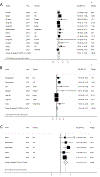Inflammation markers and risk of developing hypertension: a meta-analysis of cohort studies
- PMID: 30700522
- PMCID: PMC6588169
- DOI: 10.1136/heartjnl-2018-314216
Inflammation markers and risk of developing hypertension: a meta-analysis of cohort studies
Abstract
Objective: To systematically assess the association of circulating inflammation markers with the future risk of hypertension.
Methods: We did a systematic literature search of PubMed and Scopus, from database inception to July 10, 2018. Prospective and retrospective cohort studies evaluating the association of circulating C reactive protein (CRP), high-sensitive CRP (hs-CRP), interleukin 6 (IL-6) and IL-1β to the risk of developing hypertension in the general population were included. The relative risks (RRs) for the top versus bottom tertiles of circulating biomarkers were calculated using a fixed-effects/random-effects model. A potential non-linear dose-response association was tested.
Results: Fourteen prospective cohort studies, two retrospective cohort studies and five nested case-control studies involving 142 640 participants and 20 676 cases were identified. The RR for the third versus first tertiles of circulating CRP was 1.23 (95% CI 1.11 to 1.35; I2=59%, n=12). The association remained unchanged after adjustment for body mass index. The RRs for other biomarkers were as follows: hs-CRP (RR 1.20, 95% CI 1.02 to 1.37; I2=74%, n=7), IL-6 (RR 1.51, 95% CI 1.30 to 1.71; I2=0%, n=5), and IL-1β (RR 1.22, 95% CI 0.92 to 1.51; I2=0%, n=3). A non-linear dose-response meta-analysis demonstrated that the risk of hypertension increased linearly with increasing circulating inflammation markers, even within the low-risk and intermediate-risk categories.
Conclusions: Higher levels of circulating CRP, hs-CRP and IL-6, but not IL-1β, were associated with the risk of developing hypertension. The association persisted in subgroups of studies defined by major sources of heterogeneity.
Keywords: hypertension; inflammatory markers; meta-analysis.
© Author(s) (or their employer(s)) 2019. No commercial re-use. See rights and permissions. Published by BMJ.
Conflict of interest statement
Competing interests: None declared.
Figures


Comment in
-
Should inflammatory pathways be targeted for the prevention and treatment of hypertension?Heart. 2019 May;105(9):665-667. doi: 10.1136/heartjnl-2018-314625. Epub 2019 Jan 30. Heart. 2019. PMID: 30700517 No abstract available.
References
-
- Kearney PM, Whelton M, Reynolds K, et al. Global burden of hypertension: analysis of worldwide data. Lancet 2005;365:217–23. - PubMed
-
- Chow CK, Teo KK, Rangarajan S, et al. Prevalence, awareness, treatment, and control of hypertension in rural and urban communities in high-, middle-, and low-income countries. JAMA 2013;310:959–68. - PubMed
-
- Bautista LE, López-Jaramillo P, Vera LM, et al. Is C-reactive protein an independent risk factor for essential hypertension? J Hypertens 2001;19:857–61. - PubMed
-
- Bautista LE, Vera LM, Arenas IA, et al. Independent association between inflammatory markers (C-reactive protein, interleukin-6, and TNF-alpha) and essential hypertension. J Hum Hypertens 2005;19:149–54. - PubMed
Publication types
MeSH terms
Substances
Grants and funding
LinkOut - more resources
Full Text Sources
Medical
Research Materials
Miscellaneous
